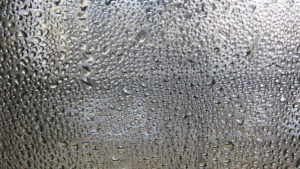 Many of us experience unwanted condensation on our windows and on the glass in our doors. This is usually worse in the winter time, but can affect us in other seasons as well.
Many of us experience unwanted condensation on our windows and on the glass in our doors. This is usually worse in the winter time, but can affect us in other seasons as well.
Why does this happen?

We see the same effect when on a hot summer day when we sit down to enjoy our
favorite refreshment.
We pour it into a glass full of ice cubes and shortly afterwards, we notice the outside
of the glass is covered in a misty moisture.
So what exactly is going on here?
You’ve probably heard the term “dew point”. It helps to understand what that term means.
Where there is warmth and water, we have airborne moisture.
Where we have airborne moisture and a cold surface, we have condensation.
So “dew point”, is the temperature below which the air can no longer suspend the moisture it holds, and it must convert back into liquid.
So, back to our icy drink. The temperature of the outside of our glass is lower than the dew point, therefore, the airborne moisture converts to liquid on the outside surface.
The same thing happens to the windows in our homes. Through the course of our living in the house, moisture is released into the air, and when the winter weather causes the temperature of the glass of our windows and doors to drop to the dew point, we find unwanted condensation forming on them.
Where this is very cool to our kids who enjoy writing special messages on the glass, this can result in maintenance issues for the adults. Excess moisture over time can lead to wear on the doors and windows, and eventually mildew and mold.
So, where is all this moisture coming from?
Much of what we do in our homes, adds moisture to the air:
Contributors to airborne moisture include baths and showers, cooking and boiling water, drying clothes, hot tubs, pools, green houses, exposed earth in crawl spaces or basements, and even breathing (seriously, even though there is not much we can do about this).
Many of the more modern homes are built to be energy efficient, and may lack enough ventilation to the outside during our colder months. So, if the humidity levels in the home rise too high, we face condensation issues.
Solutions!
So what can I do to be proactive about this?
Baths and Showers
Most bathrooms have a ventilation fan in them. Be sure to run this fan, not only during your bath or shower, but even after, until you see that all glasswork, like mirrors and vanity doors, are free from moisture. You may want to consider an upgrade to a high capacity fan, if you find the one you currently have is not sufficient to exhaust the moisture created by your bath or shower. Understandably, the longer your showers and baths are, the more moisture is released into the air. So, if you have a real problem, you may want to consider limiting your tub time.
Cooking and boiling water
While letting our inner chef loose or making that cup of coffee or tea we so enjoy, we are inadvertently releasing moisture into the air. We can minimize this by venting that moisture using the exhaust fan above the stoves. If you don’t have one, this could be an investment worth considering.
Keeping lids on pots in which we are boiling water will limit the amount of moisture escaping. You’ll also enjoy the added benefit of having your water boil quicker and be able to get to the eating part faster.
Drying clothes
Most people use tumble dryers which are vented to the outside to expel unwanted moisture. Some people prefer to hang their clothes indoor to dry to protect delicate items, to extend the life of their clothing or to preserve power. A factor to consider here is that all that moisture in those air-drying clothes goes somewhere as the clothes dry, and that is straight into the air. One source states that hanging clothes to dry can add 7 litres of moisture to your indoor air. If you’re totally set on this method, you could minimize the moisture problem by running a quality dehumidifier in the same space as your drying clothes.
Hot tubs, Pools and Greenhouses.
You’ll want to make sure areas of your home that are moisture producing by nature have separate ventilation that is adequate for the space, and that your home’s heating system does not draw any of the air from those spaces into it (like cold air returns). Any doors or windows to these areas, that join it to the rest of house should remain closed at all times.
Exposed Earth
If your home has a crawl space or basement that is bare earth, you may consider using a ground cover over it during the winter months to act as a moisture barrier.
Other Considerations
Beyond modifying some of our behaviors there are other things we can consider.
If you have a humidifier in your home, as the temperature outside drops, you’ll want to decrease the humidity in the home
Make sure you have proper ventilation in the home, especially in areas where excess moisture is likely to occur.
If you have ceiling fans in your home, run them to keep ventilation going in spaces where you find condensation appearing on windows.
Open curtains and blinds during the daylight hours. Closed curtains and blinds restricts the air movement and increases the chances for condensation forming on the cold glass surface.
A quality dehumidifier may be necessary if, despite your best efforts, you continue to have a moisture problem.
There are other solutions to consider, such as a heat recovery ventilator, for which you would need to consult an HVAC professional.

Recent Comments